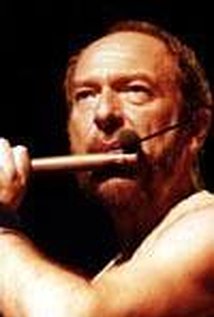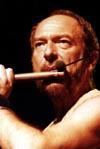Ian Anderson, born in Fife, Scotland, is one of the most famous and innovative flute-players of the last 40 years. A singer and composer, Anderson is also a multi instrumentalist, including acoustic and electric guitars, saxophone, percussion, keyboards, bagpipe, violin, balalaika, clarinet and a large variety of whistles. He is the lead vocalist a...
Show more »
Ian Anderson, born in Fife, Scotland, is one of the most famous and innovative flute-players of the last 40 years. A singer and composer, Anderson is also a multi instrumentalist, including acoustic and electric guitars, saxophone, percussion, keyboards, bagpipe, violin, balalaika, clarinet and a large variety of whistles. He is the lead vocalist and founding member of the rock band Jethro Tull. As flute-player, Anderson is self-taught, his style inspired by another accomplished flautist, Rahsaan Roland Kirk. In 1963 his fellow school friends Barriemore Barlow (drums), John Evan (keyboards), Jeffrey Hammond Hammond (bass guitar) and Michael Stephens (guitar), with Anderson taking singing and harmonica playing duties, form their first band The Blades, a soul and blues outfit. In 1965 they regroup into The John Evan Band with major lineup changes. They disband two years later when Anderson moves to Luton. In his new surroundings, Ian meets the drummer Clive Bunker and the guitarist Mick Abrahams, formerly of McGregor's Engine. With Glenn Cornick, a bassist - of The John Evan Band-, Anderson creates the seed of the group that would become the legendary Jethro Tull. Later, the band would have an ongoing change of members. The most important being the incorporation of Martin Lancelot Barre (guitar), the only musician to remain in the band for more than four decades, he replaced Mick Abrahams in 1969. They also gained Mark Craney (drummer), David Palmer (orchestral arranger) and Eddie Jobson (keyboards and violin, ex-UK,Roxy Music) Andersons style is largely based in flutter tonguing (frullato), and hole shading. Alongside his musical pursuits, he and his wife are the owners of a group of companies including salmon farms in the UK, and as far reaching as Chile, South America. The singer has survived a serious deep vein thrombosis, suffered after air travel. His voice has also suffered in his later years with vocal chord problems. Ian Andersons style mixes folk, celtic, jazz, rock, blues and pop, and his lyrics are complex, acerbic and critical of society and religion.
Show less «




